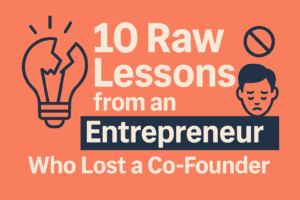Finding effective sales strategies for small business success is essential for standing out in today’s competitive market. Whether you’re just starting out or looking to boost your current sales, the right techniques can help you connect with your audience, build trust, and drive revenue. In this blog post, we’ll explore practical and proven sales strategies that small businesses can implement to achieve sustainable growth and lasting customer loyalty. Let’s dive in!
Table of Contents
11 Proven Sales Strategies for Small Businesses
Here are 13 proven sales strategies that small businesses can use to boost revenue, connect with customers, and achieve sustainable growth.
1. Understand Your Target Audience
Understanding your target audience is the cornerstone of successful sales strategies for small businesses. Without knowing who your ideal customers are, it’s nearly impossible to tailor your offerings and communication to meet their needs. Here’s how you can identify and connect with your audience effectively.
Create Detailed Customer Personas
A customer persona is a fictional representation of your ideal customer. It includes details such as demographics, interests, pain points, and buying behaviors.
⚙️ How to create customer personas:
- Analyze existing customer data.
- Conduct surveys and interviews to gather direct feedback.
- Use tools like Google Analytics or social media insights to track audience behavior.
When you have a clear picture of your audience, you can craft messages that truly resonate with them.
Identify Pain Points and Need
Your customers are looking for solutions to their problems. Identifying these pain points helps you position your product or service as the ideal solution.
⚙️ Steps to uncover pain points:
- Monitor online reviews of similar products or services.
- Pay attention to questions or concerns shared on social media or forums.
- Engage directly with your customers through polls or Q&A sessions.
Segment Your Audience
Not all customers are the same. By segmenting your audience based on characteristics like location, purchase history, or engagement levels, you can deliver personalized experiences that increase conversions.
⚙️ Examples of segmentation:
- Send promotional emails to frequent buyers.
- Offer localized deals based on customer location.
- Create tailored ads for different demographics.
Keep Your Research Updated
Customer needs and behaviors change over time. Regularly revisiting your research ensures your strategies remain effective.
⚙️ Tips to stay updated:
- Use customer feedback to refine your personas and strategies.
- Monitor industry trends to anticipate shifts in preferences.
- Analyze sales data to identify patterns and emerging opportunities.
2. Create a Clear Value Proposition
A clear value proposition is the foundation of effective sales strategies for small businesses. It explains why customers should choose your product or service over competitors. A compelling value proposition helps attract your ideal audience, builds trust, and drives conversions. Here’s how to craft and communicate a strong value proposition.
Understand What Makes Your Business Unique
Start by identifying what sets your business apart. Your unique selling point (USP) forms the core of your value proposition.
⚙️ Questions to ask:
- What problem does your product or service solve?
- How does it benefit your customers?
- What features or qualities make your offering different or better than others?
Keep It Customer-Centric
Your value proposition should focus on the customer and how your product or service improves their life or solves their problem. Avoid using jargon or overly technical language.
⚙️ Example:
Instead of saying, “Our software has advanced analytics,” say, “Our software helps you track your business performance in real-time so you can make smarter decisions.”
Be Specific and Tangible
Vague promises don’t resonate with customers. Your value proposition should clearly communicate the specific benefits they’ll gain.
⚙️ Tips for specificity:
- Use measurable outcomes, like “Save 20% on energy bills” or “Increase productivity by 30%.”
- Highlight time-saving features or cost-saving advantages.
- Include social proof or endorsements if possible.
Use a Simple, Memorable Format
Craft a short, punchy statement that’s easy to remember and communicates your value at a glance.
⚙️ Formula for a value proposition:
- [What you offer] + [Who it’s for] + [Key benefit/solution it provides].
- Example: “Affordable marketing solutions for small businesses to grow their customer base effortlessly.”
Test and Refine Your Message
Your value proposition should evolve as you learn more about your customers and their preferences. Gather feedback and analyze data to refine it over time.
⚙️ How to test your value proposition:
- Conduct A/B tests with different messaging on your website or ads.
- Ask for customer feedback directly through surveys or interviews.
- Monitor conversion rates to see which version performs best.
Integrate It Across All Channels
Your value proposition should be prominently displayed and consistently communicated across your marketing and sales channels.
⚙️ Where to showcase it:
- Website homepage and landing pages.
- Social media profiles and advertisements.
- Email campaigns and printed materials.
3. Build Strong Relationships with Customers
Building strong relationships with customers is one of the most impactful sales strategies for small businesses. Loyal customers are more likely to make repeat purchases, refer others, and advocate for your brand. Here’s how small businesses can establish and nurture lasting connections with their audience.
Personalize Your Communication
Customers appreciate businesses that treat them as individuals, not just transactions. Personalized communication helps you connect with your audience on a deeper level.
⚙️ How to personalize effectively:
- Use customers’ names in emails and messages.
- Send personalized product recommendations based on their purchase history.
- Celebrate special occasions like birthdays with tailored offers.
Listen to Customer Feedback
Listening to your customers demonstrates that you value their opinions. Feedback helps you improve your products or services while building trust.
⚙️ Ways to gather feedback:
- Use surveys and feedback forms after a purchase.
- Encourage online reviews and respond to them professionally.
- Pay attention to comments and messages on social media.
Be Proactive in Communication
Don’t wait for customers to reach out with problems—be proactive in keeping them informed and engaged.
⚙️ Examples of proactive communication:
- Notify customers about shipping delays or product updates.
- Share helpful content, such as tips on using your product.
- Check in with past customers to ask about their experience.
4. Leverage Social Proof
Leveraging social proof is one of the most effective sales strategies for small businesses. Social proof reassures potential customers that others trust and value your product or service. This builds credibility, boosts conversions, and encourages hesitant buyers to take action. Here’s how you can use social proof to grow your small business.
Showcase Customer Testimonials
Testimonials are a powerful way to highlight the positive experiences of your satisfied customers. They make your business more relatable and trustworthy.
⚙️ How to use testimonials effectively:
- Add testimonials to your website’s homepage, product pages, or checkout page.
- Use quotes that highlight specific benefits of your offerings.
- Include photos or names (with permission) to make testimonials more authentic.
Highlight Online Reviews and Ratings
Online reviews and ratings play a significant role in influencing purchase decisions. A high star rating or glowing reviews can convince potential customers to choose your business.
⚙️ How to leverage reviews:
- Claim your business on review platforms like Google My Business, Yelp, or Trustpilot.
- Regularly encourage happy customers to leave reviews.
- Respond to reviews—both positive and negative—to show you care about feedback.
Share Case Studies and Success Stories
Case studies demonstrate how your product or service has solved real problems for customers. They provide detailed examples that potential clients can relate to.
⚙️ Steps to create effective case studies:
- Identify a satisfied customer with measurable results.
- Outline their challenges, your solution, and the outcomes.
- Use visuals like charts or before-and-after images to illustrate the impact.
Highlight Influencer Endorsements
Partnering with influencers who resonate with your target audience can amplify your social proof. Their endorsement can introduce your business to a broader audience.
⚙️ How to use influencer endorsements:
- Collaborate with micro-influencers in your niche for authenticity.
- Share posts or stories from influencers using your product.
- Add influencer quotes or logos to your website.
Display Trust Badges and Certifications
Trust badges, certifications, and awards reassure customers that your business is legitimate and credible. They are especially important for online businesses.
⚙️ Examples of trust badges:
- Secure payment icons like “Verified by Visa” or “SSL Certified.”
- Memberships in industry associations.
- Awards or recognitions your business has received.
Use Real-Time Proof Widgets
Real-time proof widgets, like pop-ups showing recent purchases or sign-ups, create a sense of activity and urgency. They demonstrate that others are actively engaging with your business.
⚙️ How to implement this:
- Use tools like Fomo or Proof to display real-time actions on your website.
- Show notifications like “John just purchased [Product Name]” or “15 people are viewing this product.”
5. Offer Incentives and Discounts Strategically
Offering incentives and discounts is a proven way to attract new customers, retain existing ones, and boost sales. However, small businesses need to use this strategy thoughtfully to maximize its effectiveness without eroding profits. Here’s how to incorporate incentives and discounts into your sales strategies for small business success.
Use Limited-Time Offers to Create Urgency

A sense of urgency can motivate customers to take immediate action. Limited-time offers tap into the fear of missing out (FOMO), encouraging quicker purchase decisions.
⚙️ Examples of limited-time offers:
- “20% off for the next 48 hours!”
- Seasonal promotions tied to holidays or special events.
- Flash sales for select products or services.
Launch Referral Programs
Referral programs incentivize your existing customers to spread the word about your business. They benefit both the referrer and the new customer, creating a win-win situation.
⚙️ How to create an effective referral program:
- Offer discounts, store credits, or free products as rewards.
- Make it easy for customers to share referral links or codes.
- Promote your program through email, social media, and your website.
Reward Loyal Customers
Loyal customers are valuable to any business. Rewarding their commitment not only retains them but also strengthens your relationship.
⚙️ Ideas for loyalty incentives:
- Points-based systems where customers earn rewards for every purchase.
- Exclusive discounts for repeat buyers.
- Early access to new products or special events.
Offer Bulk Discounts or Bundles
Encouraging customers to buy more can increase your average order value. Bundling complementary products or offering discounts on bulk purchases is an effective way to do this.
⚙️ Examples of bundling and bulk discounts:
- “Buy 2, get 1 free” offers.
- Discounts for orders over a specific amount (e.g., “10% off orders over $100”).
- Bundles like “Starter Kits” with multiple products at a reduced price.
Tailor Discounts to Specific Customer Segments
Targeted discounts are more effective than blanket offers. Tailoring incentives to specific customer groups ensures relevance and better results.
⚙️ Examples of targeted discounts:
- First-time buyer discounts to attract new customers.
- Exclusive offers for newsletter subscribers.
- Special discounts for returning customers who haven’t purchased in a while.
Use Discounts to Clear Inventory
Discounts are a great way to move slow-selling or seasonal items, freeing up space for new inventory.
⚙️ Tips for inventory-clearing discounts:
- Create “End of Season” sales.
- Use “Last Chance” messaging to promote discontinued items.
- Bundle older inventory with popular products.
Track and Analyze Results
Offering discounts without tracking their performance can hurt profitability. Use data to measure the success of your campaigns and make adjustments.
⚙️ Metrics to monitor:
- Increase in sales during the promotional period.
- Customer acquisition and retention rates.
- Overall impact on profit margins.
6. Focus on Upselling and Cross-Selling
Focusing on upselling and cross-selling is a smart and cost-effective way to boost revenue for small businesses. By encouraging customers to spend more during a single transaction, you maximize the value of each sale while enhancing their experience with your business. Here’s how you can effectively integrate upselling and cross-selling into your sales strategies for small business success.
The Difference Between Upselling and Cross-Selling
- Upselling: Encouraging customers to purchase a higher-priced version or additional features of the product they’re considering.
- Example: Recommending a premium version of a software plan.
- Cross-Selling: Suggesting complementary products or services to what the customer is already buying.
- Example: Offering a phone case and screen protector with a smartphone.
Offer Relevant Recommendations
The key to successful upselling and cross-selling is relevance. Customers are more likely to accept your suggestions if they align with their current purchase or needs.
⚙️ How to make relevant offers:
- Analyze purchase patterns to identify complementary products.
- Use customer data to personalize recommendations.
- Avoid overloading customers with irrelevant suggestions.
Highlight the Benefits
When suggesting an upsell or cross-sell, focus on the added value it provides. Help the customer understand how the recommendation enhances their purchase.
⚙️ Examples of highlighting benefits:
- Explain how the upgraded product saves time or improves efficiency.
- Show how a complementary item enhances the main product’s utility.
- Use phrases like “Best Value” or “Most Popular Choice” to guide decisions.
Use Bundling to Encourage Cross-Selling
Bundling is an effective way to cross-sell by grouping related products together at a discounted price.
⚙️ Examples of bundling:
- “Starter Kits” with essential items.
- Discounts on multi-product purchases (e.g., “Save 15% when you buy 3 or more”).
- Pre-packaged solutions for specific needs.
Leverage Timing and Placement
The timing and placement of your upselling and cross-selling efforts can significantly impact their success.
⚙️ Tips for effective timing and placement:
- Suggest upgrades during the decision-making process (e.g., before checkout).
- Use post-purchase emails to recommend complementary items.
- Display cross-sell items on product pages and in shopping carts.
Monitor and Optimize Your Strategy
Not every upselling or cross-selling tactic will work for your business. Regularly monitor results and refine your approach based on performance.
⚙️ Metrics to track:
- Average order value (AOV).
- Conversion rates for upsells and cross-sells.
- Customer feedback on recommendations.
7. Optimize Your Online Presence
In today’s digital world, having a strong online presence is critical for any business. For small businesses, optimizing your online presence can significantly enhance visibility, attract more customers, and increase sales. Integrating this step into your sales strategies for small business success is essential. Here’s how to do it effectively.
Build a Professional Website
Your website is the cornerstone of your online presence. It should be user-friendly, visually appealing, and aligned with your brand.
⚙️ Key elements of a great website:
- Mobile responsiveness for seamless use on any device.
- Fast loading times to keep visitors engaged.
- Clear navigation to help users find information easily.
Leverage Search Engine Optimization (SEO)
SEO is vital for ensuring your business appears in search results when potential customers look for products or services you offer.
⚙️ SEO tips for small businesses:
- Use relevant keywords in your website content.
- Optimize meta titles, descriptions, and alt tags for images.
- Create high-quality, informative blog posts to attract organic traffic.
Establish a Strong Social Media Presence
Social media platforms provide an excellent opportunity to connect with your audience, showcase your products, and build relationships.
⚙️ How to optimize social media:
- Choose platforms where your target audience spends the most time.
- Maintain a consistent posting schedule with engaging content.
- Use paid ads to reach a wider audience and promote your value proposition.
Claim and Optimize Local Listings
For small businesses, local visibility can be a game-changer. Claiming and managing online listings ensures potential customers can find you easily.
⚙️ Steps to optimize local listings:
- Create or claim your profile on Google My Business.
- Ensure your name, address, and phone number (NAP) are consistent across all platforms.
- Collect and display customer reviews to boost credibility.
Use Email Marketing Effectively
Email marketing allows you to nurture leads, stay connected with customers, and promote offers directly to their inbox.
⚙️ Tips for email marketing success:
- Build a subscriber list through website sign-ups or social media.
- Personalize emails with the recipient’s name and relevant offers.
- Track open and click-through rates to refine your campaigns.
Invest in Paid Online Advertising
Paid ads can deliver quick results by driving traffic to your website or social media profiles.
⚙️ Common paid advertising channels:
- Google Ads for targeting search queries relevant to your products.
- Social media ads on platforms like Facebook, Instagram, or LinkedIn.
- Retargeting ads to bring back visitors who didn’t convert initially.
Monitor and Improve Your Online Reputation
Your online reputation is a critical part of your presence. Customers often check reviews and ratings before making a purchase decision.
⚙️ How to manage your reputation:
- Respond promptly to customer reviews—both positive and negative.
- Address complaints professionally and offer solutions.
- Encourage satisfied customers to leave positive reviews.
8. Implement a Follow-Up Strategy
A follow-up strategy is one of the most powerful sales strategies for small business success. Many potential sales are lost simply because businesses fail to reconnect with leads or customers after the initial interaction. By staying top-of-mind and showing continued interest, you can build stronger relationships and convert more opportunities into sales.
Understand the Importance of Follow-Ups
Following up shows customers you value their business and are committed to meeting their needs.
⚙️ Why follow-ups matter:
- They remind prospects about your product or service.
- They provide an opportunity to address objections or concerns.
- They help nurture leads who aren’t ready to buy immediately.
Segment Your Leads
Not all customers or leads are the same, so your follow-up approach should vary accordingly.
⚙️ How to segment leads:
- Hot leads: Follow up quickly with an offer or additional information.
- Warm leads: Provide nurturing content, such as case studies or testimonials.
- Cold leads: Use periodic reminders or updates to re-engage them.
Use Multiple Communication Channels
A successful follow-up strategy uses a combination of methods to ensure your message is seen.
⚙️ Effective follow-up channels:
- Email: Send personalized thank-you notes, updates, or promotions.
- Phone calls: Great for building rapport and addressing specific concerns.
- Social media: Engage with leads through direct messages or comments.
- Text messages: Perfect for quick updates or reminders about upcoming offers.
Time Your Follow-Ups Strategically
Timing is crucial for follow-up success. Follow up promptly after initial contact but avoid being overly persistent.
⚙️ General timing tips:
- Send a follow-up email within 24–48 hours of the first interaction.
- Space out subsequent follow-ups, such as weekly or bi-weekly, based on customer behavior.
- Use automated tools to schedule and manage follow-ups effectively.
Add Value in Every Interaction
Your follow-up messages should always offer something valuable to the recipient.
⚙️ Ways to add value:
- Share relevant resources, like blog posts, guides, or product demos.
- Provide solutions tailored to their needs or questions.
- Offer discounts or exclusive deals to encourage action.
Track and Measure Results
Monitor the effectiveness of your follow-up strategy to identify what works best.
⚙️ Metrics to track:
- Open and click-through rates for follow-up emails.
- Conversion rates after follow-ups.
- Customer feedback on the follow-up process.
9. Collaborate with Other Businesses

Collaboration is a strategic way for small businesses to expand their reach, attract new customers, and enhance credibility. Partnering with complementary businesses can unlock new opportunities, allowing you to achieve shared goals while boosting sales. Incorporating collaboration into your sales strategies for small business growth can deliver powerful results.
Identify Complementary Businesses
The key to a successful collaboration is finding businesses that align with your products or services without being direct competitors.
⚙️ Examples of complementary partnerships:
- A bakery collaborating with a local coffee shop.
- A fitness studio partnering with a sports equipment retailer.
- A web design agency teaming up with a digital marketing firm.
Co-Host Events or Promotions
Collaborative events and promotions can attract customers to both businesses while creating a buzz in your community.
⚙️ Ideas for events and promotions:
- Host joint workshops or webinars to share expertise.
- Create bundled offers combining products or services from both businesses.
- Participate in local fairs or markets together.
Share Customer Bases
Leveraging each other’s customer bases can significantly increase exposure for both businesses.
⚙️ How to share audiences effectively:
- Offer exclusive discounts to each other’s customers.
- Promote each other’s products through newsletters or social media.
- Display flyers or brochures at each other’s physical locations.
Cross-Promote on Social Media
Social media is an excellent platform for collaborative marketing. By sharing each other’s content, you can reach new audiences and enhance brand visibility.
⚙️ Tips for cross-promotion:
- Tag your partner business in posts and encourage mutual engagement.
- Create joint social media campaigns with branded hashtags.
- Host giveaways featuring products from both businesses.
Develop Co-Branded Products or Services
Co-branding allows you to create unique offerings that appeal to both businesses’ audiences.
⚙️ Examples of co-branding:
- A clothing store and a local artist designing a limited-edition apparel line.
- A beauty salon and a skincare company creating a special product package.
- A tech startup and a hardware company launching a bundled solution.
Support Local Community Initiatives Together
Joining forces to support community initiatives can enhance your brand reputation and foster goodwill.
⚙️ Community-focused collaboration ideas:
- Sponsor a local charity event or sports team.
- Organize a neighborhood cleanup or donation drive.
- Host free workshops or training sessions for the community.
Formalize the Collaboration
To ensure smooth cooperation, formalize your partnership with clear goals and expectations.
⚙️ Steps to formalize a collaboration:
- Create a written agreement outlining responsibilities and benefits for each party.
- Define key metrics for success, such as increased foot traffic or sales.
- Schedule regular check-ins to assess progress and address challenges.
10. Invest in Sales Training
One of the most effective sales strategies for small business growth is to invest in sales training for yourself and your team. A well-trained sales team not only drives revenue but also enhances customer satisfaction and builds trust. By equipping your team with the right skills and techniques, you can maximize every opportunity to close deals and grow your business. Here is how to approach this…
Identify Key Training Areas
Tailor your sales training program to address the specific needs of your business and team.
⚙️ Important training topics include:
- Product knowledge: Deep understanding of your offerings.
- Customer relationship management (CRM): Efficiently tracking and managing leads.
- Effective communication: Active listening and persuasive speaking.
- Negotiation skills: Closing deals with mutually beneficial outcomes.
Choose the Right Training Format
Different formats work better depending on your business size, budget, and goals.
⚙️ Training options to consider:
- Workshops: Interactive sessions for skill-building and role-playing.
- Online courses: Flexible learning at a lower cost.
- One-on-one coaching: Personalized guidance for individual growth.
- Webinars: Convenient options for remote teams or tight schedules.
Use Real-Life Scenarios
Training that includes real-life scenarios helps your team practice handling challenges they’ll face in the field.
⚙️ Examples of scenarios to include:
- Overcoming customer objections.
- Presenting upsell and cross-sell opportunities.
- Handling difficult customers with professionalism.
Measure Training Effectiveness
Investing in sales training is only worthwhile if it delivers results. Monitor the impact of training on your team’s performance.
⚙️ Metrics to track:
- Increase in lead conversions.
- Improvement in average sales per customer.
- Enhanced customer feedback and satisfaction scores.
Make Training a Continuous Process
Sales techniques and market conditions evolve, so training should be ongoing.
⚙️ How to ensure continuous improvement:
- Schedule regular refresher courses.
- Encourage attendance at industry conferences and events.
- Provide access to updated resources, like eBooks, webinars, and case studies.
11. Use Data to Make Informed Decisions

In today’s competitive landscape, using data effectively is one of the most impactful sales strategies for small business success. Data-driven decisions allow you to understand your customers better, optimize your sales process, and identify growth opportunities. By leveraging data, small businesses can stay ahead of the competition and ensure every strategy is based on actionable insights. Here is how to maximise this approach for your business
Collect Relevant Data
The first step is to gather data that aligns with your business objectives.
⚙️ Types of data to collect:
- Customer data: Demographics, preferences, purchase history, and feedback.
- Sales metrics: Conversion rates, average transaction values, and sales by channel.
- Market trends: Competitor performance, industry benchmarks, and seasonal shifts.
Analyze Customer Behavior
Understanding how customers interact with your business helps tailor your sales strategies to meet their needs.
⚙️ What to look for in customer behavior data:
- Purchase patterns, such as popular products or repeat purchases.
- Time spent on your website or specific product pages.
- Customer feedback trends indicating pain points or satisfaction drivers.
Track Key Performance Indicators (KPIs)
Monitoring the right KPIs provides clarity on what’s working and what needs improvement in your sales efforts.
⚙️ Important KPIs for small businesses:
- Lead-to-customer conversion rate.
- Sales growth percentage.
- Customer acquisition cost (CAC).
- Customer lifetime value (CLV).
Use Tools to Simplify Data Management
Data management tools make it easier to collect, analyze, and interpret insights.
⚙️ Popular tools for small businesses:
- Customer Relationship Management (CRM) software: Manage leads and track customer interactions.
- Analytics platforms: Tools like Google Analytics for website data.
- Sales tracking software: Monitor pipeline performance and forecast trends.
Make Data-Driven Adjustments
Using insights from data, refine your sales strategies to better align with customer needs and market conditions.
⚙️ Examples of data-driven decisions:
- Adjust pricing based on customer purchase trends and competitor analysis.
- Focus marketing efforts on channels generating the highest ROI.
- Develop new products or services based on customer feedback and demand.
Predict Future Trends
Data can help you anticipate customer needs and market shifts, enabling proactive decision-making.
⚙️ How to use data for forecasting:
- Analyze historical sales data to identify seasonal trends.
- Use predictive analytics tools to estimate future demand.
- Monitor industry reports to stay ahead of emerging trends.
Conclusion
Boosting sales as a small business can feel like an uphill battle, but with the right strategies, success is within reach. By implementing these proven sales strategies for small business growth, you can better understand your audience, build meaningful relationships, and position your business as a trusted solution in your market.
Each strategy—from leveraging social proof and optimizing your online presence to investing in sales training and collaborating with other businesses—plays a crucial role in driving revenue and customer loyalty. Remember, consistency and adaptability are key. Continuously evaluate your efforts, learn from your data, and refine your approach to meet changing customer needs and market trends.
No matter the size of your business, these strategies offer actionable insights to help you stand out, connect with customers, and achieve sustainable growth. Start implementing them today and watch your small business thrive!










